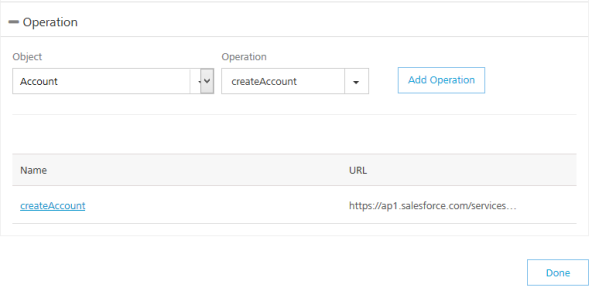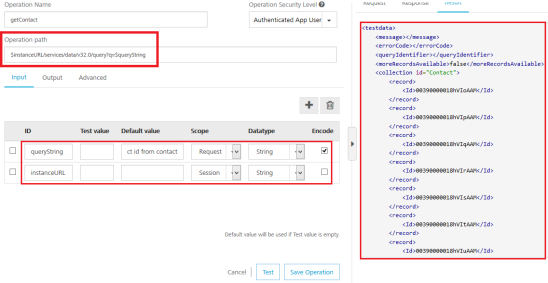Salesforce Adapter
User Guide: Integration > Configure the Integration Service > Salesforce Adapter
Salesforce Adapter
Configure Salesforce Endpoint Adapter
To configure Salesforce service in the Integration Service Definition tab, follow these steps:
- In the Name field, provide a unique name for your service.
- From the Service Type list, select Salesforce.
- Provide the following details to create the Salesforce service:
| Field | Description |
|---|---|
| Authentication | Use Existing Identity Provider - to select an identity provider. This drop-down lists all identity providers only if you have already created identity providers for SAP in the Identity page. Fill in the details for the following fields: |
| From the Select Identity Provider list, select your Salesforce identity.The details for the selected identity are displayed in the Endpoint URL text box. You cannot modify these details.Under the User ID and Password, provide valid log-in credentials that you created while registering with Salesforce services. |
Specify Login Endpoint- to configure a new endpoint. Fill in the details for the following fields:
In the Endpoint URL, enter the URL - for example, https://login.salesforce.com/services/oauth2/token_._In the Client ID text box, enter a valid client id.In the Client Secret text box, enter a valid client secret.In the User ID text box, enter a valid user ID.In the Password text box, enter a valid password.
|
-
Field Description Custom Code Custom Code enables you to specify dependent JAR. To specify dependent JAR, select the JAR containing preprocessor or postprocessor libraries from the drop-down list, or click Upload New to browse the JAR file from your local system. This step allows you to further filter the data sent to the back end. > Important: Make sure that you upload a custom JAR file that is built on the same JDK version used for installing Volt MX Foundry Integration.For example, if the JDK version on the machine where Volt MX Foundry Integration is installed is 1.6, you must use the same JDK version to build your custom jar files. If the JDK version is different, an unsupported class version error will appear when a service is used from a device. Throttling API throttling enables you to limit the number of request calls within a minute. If an API exceeds the throttling limit, it will not return the service response. To specify throttling in Volt MX Foundry Console, follow these steps: In the Total Rate Limit text box, enter a required value. With this value, you can limit the number of requests configured in your Volt MX Foundry console in terms of Total Rate Limit. In the Rate Limit Per IP text box, enter a required value. With this value, you can limit the number of IP address requests configured in your Volt MX Foundry console in terms of Per IP Rate Limit. To override throttling in App Services Console, refer to Override API Throttling Configuration. > Note: In case of On-premises, the number of nodes in a clustered environment is set by configuring the
VOLTMX_SERVER_NUMBER_OF_NODESproperty in the Admin Console. This property indicates the number of nodes configured in the cluster. The default value is 1.Refer to The Runtime Configuration tab on the Settings screen of App Services.The total limit set in the Volt MX Foundry Console will be divided by the number of configured nodes. For example, a throttling limit of 600 requests/minute with three nodes will be calculated to be 200 requests/minute per node.This is applicable for Cloud and On-premises. |Note: All the fields in the Advanced section are optional.
-
In the Description field, provide a suitable description for the service.
-
To enable the proxy, select the Use proxy from settings check box. By default, the check box is cleared. The Use proxy from settings check box dims when no proxy is configured under the Settings > Proxy.
-
Click Save to save your service definition.
Create Operations for Salesforce
The Operations List tab appears only after the service definition is saved.
Note: Click Operations List tab > Configure Operation. The Configured Operations list appears.
To create an operation, follow these steps:
-
Click SAVE & ADD OPERATION in your service definition page to save your service definition and display the NewOperation tab for adding operations.
OR
Click Add Operation to add a new operation or from the tree in the left pane, click Add > Add New Operation. -
Select an object from the Object list that is auto-populated with all the existing Salesforce objects.
Note: If you provide incorrect Salesforce endpoint details, the Object list will contain only _Login object.
-
Based on the object added in the previous step, the Operation Name is listed with operations. Select the check boxes for required operations.
- Based on the object selected, a list of operations is displayed in the dropdown. Select the required operations and click Add Operation.
- The selected operations are added to the Operations List section and the new Salesforce service is added to the Integration page.

- To edit an operation, either click on the required operation name or click Edit from the Settings in the Operations List screen. The operation details page is displayed.

-
To configure an operation, provide the following details:
Field Description Name Enter a unique name for your operation. Operation Security Level It specifies how a client must authenticate to invoke this operation.  Select one of the following security operations in the Operation Security Level field.
Select one of the following security operations in the Operation Security Level field.Authenticated App User – It restricts the access to clients who have successfully authenticated using an Identity Service associated with the app. Anonymous App User – It allows the access from trusted clients that have the required App Key and App Secret. Authentication through an Identity Service is not required. Public – It allows any client to invoke this operation without any authentication. This setting does not provide any security to invoke this operation and you should avoid this authentication type if possible. Private - It blocks the access to this operation from any external client. It allows invocation either from an Orchestration/Object Service, or from the custom code in the same run-time environment.
| | Operation Path | Modify the path if required. > Note: If you provide incorrect Salesforce endpoint details, the Object list will contain only _Login object. |
-
Field Description Custom Code Invocation You can add pre and post processing logic to services to modify the request inputs. When you test, the services details of various stages in the service execution are presented to you for better debugging. All options in the Advanced section are optional. For more details, refer to Preprocessor and Postprocessor. Properties Additional configuration properties (timeout, cachable, unescape embedded xml in response, response encoding, number of connection retries allows you to configure service call time out cache response Front-end API It allows you map your endpoint (or) backend URL of an operation to a front-end URL. Server Events Using Server Events you can configure this service to trigger or process server side events. For detailed information, refer Server Events. Note: All options in the Advanced section are optional.
Configure Request Operation for Salesforce
Integration services accept only form-url-encoded inputs for all the input parameters provided in the service input parameters (request input).
You can perform the following actions in Request Input tab:
- Click Add Parameter to add an entry (if the entries for input and the output tabs does not exist).
- To make duplicate entries, select the check box for the entry, click Copy and Paste.
- To delete an entry, select the check box for an entry and click Delete .
- To configure the Request Input tab, provide the following details:
| Field | Description |
|---|---|
| Name | It Contains a Unique Identifier. Change the name if required. |
| Test Value | Enter a value. A test value is used for testing the service. |
| Default Value | Enter the value, if required. The default value will be used if the test value is empty. |
| Scope | Select Request or Session. It is set to Request by default. Request indicates that the value must be retrieved from the HTTP request received from the mobile device. Session indicates that the value must be retrieved from the HTTP session stored on Volt MX Foundry. |
| Datatype | |
 Select one of the following data types. Select one of the following data types. |
String - A combination of alpha-numeric and special characters. Supports all formats including UTF-8 and UTF-16 with no maximum size limit. Date - Date formatIf data type is string, then the options in the Format Type are Currency, Number and Date.If the data type is number, then the options in the Format Type are Currency and Date. If the data type is boolean, then the options in the Format Type and Format Value text box are disabled. Boolean - A value that can be true or false. Number - An integer or a floating number. Collection - A group of data, also referred as data set.
| | Encode | Select the check box to enable encoding of an input parameter. For example, the name New York Times would be encoded as New_York_Times when the encoding is set to True. The encoding must also adhere to the HTML URL encoding standards. |
- To validate the operation details, click Save and Test. For more details, refer to Test a Service Operation.
Configure Response Operation for Salesforce
-
Click the *Output* tab, and enter the values for required fields such as ID, scope, data type, collection ID, record ID, format and format value.
Note: If you define parameters inside a record as the session, the session scope will not get reflected for the parameters.
-
To validate the operation details, click Save and Test. For more details, refer to Test a Service Operation.
-
Click Save Operation to save the operation. The system displays the Operation section for your service.
-
Click Done to navigate to the Integration page.
Note: To use an existing integration service, refer to How to Use an Existing Integration Service.
Note: You can view the service in the Data Panel feature of Volt MX Iris. By using the Data Panel, you can link back-end data services to your application UI elements seamlessly with low-code to no code. For more information on Data Panel, click here.
How to Use Log-in Endpoint with Different Credentials for Design Time and Runtime
If the service is using a log-in endpoint, ensure that you specify the same set of credentials (Client ID, Client Secret, User ID, Password) for design time and run-time.
If the log-in endpoint credentials are different for design time and run-time, the system throws an error while accessing a service from an app.
Error 401: Request Unsuccessful Server responded with 401.
If you want to the use log-in endpoint with different credentials for design time and run-time, then parametrize instance URL in the operation path, and send that URL from an app.
For example:
To parametrize an instance URL, follow these steps:
-
In the login operation, click Output tab, and make the following changes:

ID Path Scope Authorization concat(//OAuth/token_type," ",//OAuth/access_token session instanceURL //OAuth/instance_url session -
Click Test to view the results.
- Click Save Operation to save the changes.
-
In the getContact operation, make the following changes:
-
In the Operation Path text box, change the URL, for example, from
https://ap1.salesforce.com/to$<instanceURL>/.
-
In the Input tab, configure the following fields as shown:
ID Path Scope Encode queryString Select ID from contact session instanceURL //OAuth/instance_url session No
-
-
Click Test to fetch the contacts from Salesforce.
- Click Save Operation.